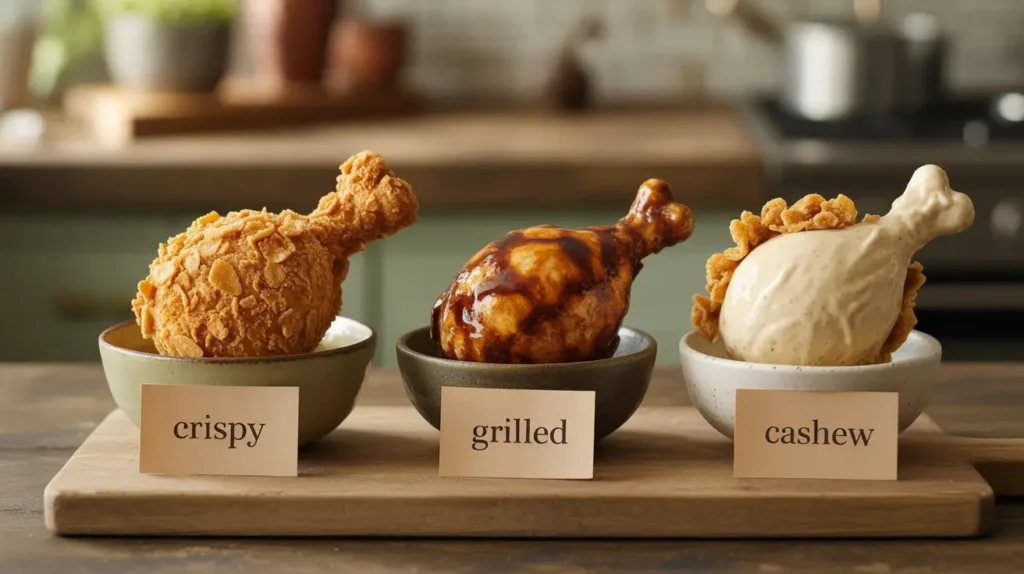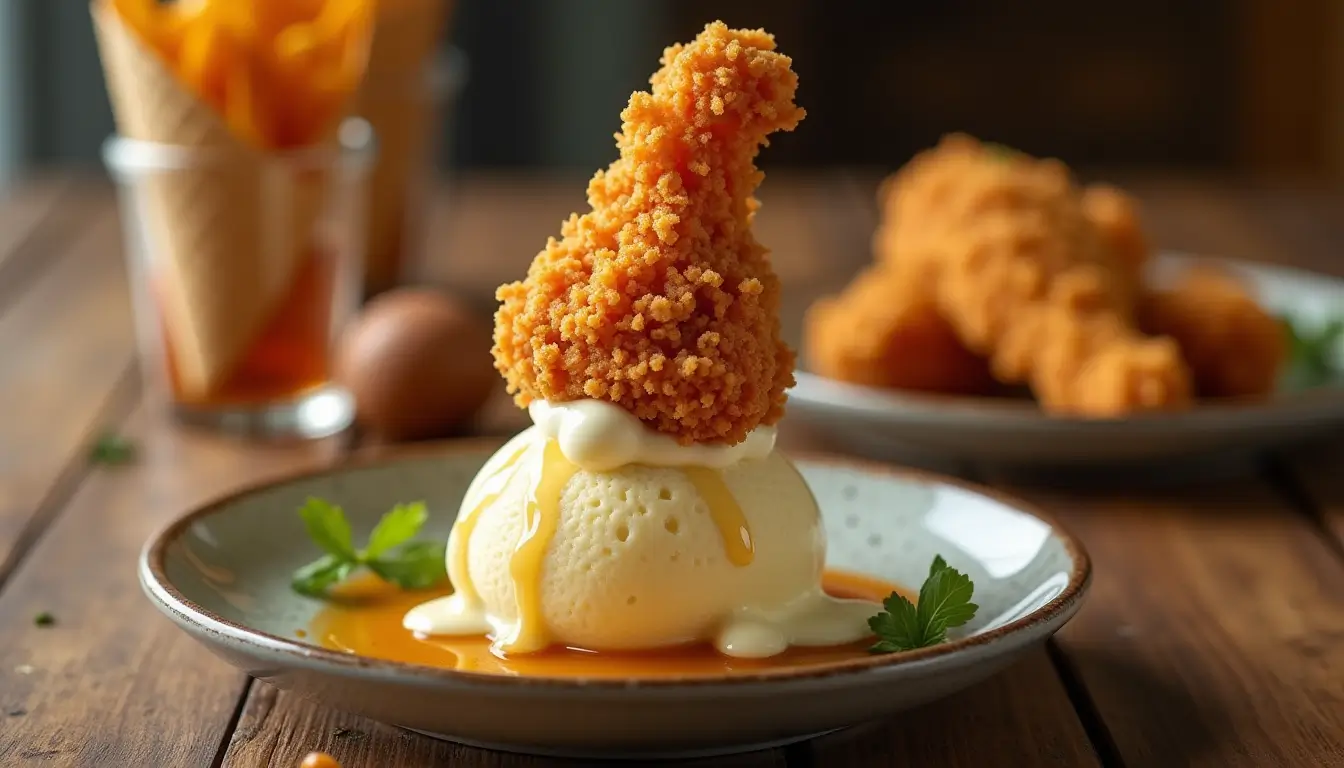Chicken Ice Cream: How This Amazing Flavor Actually Works
Picture this: You’re scrolling through social media when suddenly, a photo stops you cold. It’s a creamy, golden scoop of ice cream that looks suspiciously like… fried chicken? Your brain does a double-take. Is this some kind of elaborate food prank, or have we finally reached the peak of culinary innovation?
Welcome to the wild world of chicken ice cream—a flavor that’s been quietly revolutionizing dessert menus and challenging everything we thought we knew about sweet treats. From fried chicken ice cream that captures the essence of your favorite comfort food to Not Fried Chicken Ice Cream that’s taking plant-based desserts to new heights, this isn’t just another quirky food trend. It’s a masterclass in culinary creativity that’s making even the most skeptical food lovers reconsider their dessert boundaries.
Whether you’re a culinary adventurer ready to embrace ice cream chicken flavors or someone who’s still processing the very concept, this deep dive will transform your understanding of what makes this seemingly impossible flavor combination actually work—and why it might just be the most ingenious dessert innovation of our time.
The Science Behind Chicken Ice Cream: Breaking Down the Flavor Profile
Understanding the Umami-Sweet Connection in Chicken Ice Cream
Your taste buds are more sophisticated than you might realize. When you encounter chicken ice cream for the first time, your palate experiences something extraordinary: the marriage of umami and sweetness that creates an entirely new flavor dimension.
Scientists at the Institute of Food Technologists have discovered that umami—that savory, meaty taste—actually enhances sweetness perception rather than competing with it. This neurological response explains why chicken ice cream doesn’t taste like a confused dessert, but rather like a harmonious blend that makes perfect sense once you experience it.
The magic happens when your taste receptors detect familiar comfort food elements within an unexpected frozen medium. Your brain recognizes the herbal notes of thyme and sage, the richness of butter compounds, and the subtle saltiness that makes everything taste more vibrant. Instead of conflict, you experience completion.
The Art of Balancing Savory and Sweet Elements
Creating successful chicken ice cream requires mastering the delicate balance between opposing flavor profiles. Professional ice cream makers use a technique called “flavor layering,” where different taste components are introduced at specific temperatures and timing intervals.
The foundation starts with a rich custard base that provides the creamy sweetness you expect from quality ice cream. Then comes the sophisticated part: herb and spice integration that mimics the aromatic profile of perfectly seasoned fried chicken without overwhelming the dessert experience.
Temperature plays a crucial role here. Cold temperatures naturally suppress some flavors while enhancing others. This means your ice cream chicken creation needs more pronounced seasoning than you might initially expect, but the proportions must remain precise to avoid crossing into savory territory.
Different Types of Chicken Ice Cream: From Fried to Plant-Based

Traditional Fried Chicken Ice Cream: The Original Innovation
Fried chicken ice cream emerged from the experimental kitchens of molecular gastronomy pioneers who wondered: “What if we could capture the essence of comfort food in frozen form?” The result surprised everyone involved.
The traditional version combines a vanilla bean custard base with a carefully crafted seasoning blend that includes:
- Herbs & Spices: Thyme, sage, paprika (intensity level 6/10)
- Cream Base: Vanilla, butter compounds (intensity level 8/10)
- Caramelized Elements: Maillard reaction compounds (intensity level 7/10)
- Salt Component: Sea salt, celery salt (intensity level 4/10)
This flavor profile creates depth and complexity that mirrors the satisfaction of biting into perfectly seasoned fried chicken, but in a refreshing, creamy format that delights rather than confuses.
Not Fried Chicken Ice Cream: Plant-Based Innovation
Not Fried Chicken Ice Cream represents the evolution of this concept into inclusive territory. Plant-based versions prove that you don’t need animal products to achieve the same satisfying flavor experience.

These innovative alternatives use:
- Cashew cream base for richness
- Coconut milk for smooth texture
- Nutritional yeast for umami depth
- Carefully balanced herbs for authentic taste
The vegan approach actually offers some advantages. Plant-based fats distribute flavors differently, sometimes creating even more pronounced herbal notes that enhance the overall ice cream chicken experience.
How to Make Ice Cream Chicken Flavored Desserts at Home
Essential Equipment and Ingredients for Chicken Ice Cream
Creating chicken ice cream at home requires standard ice cream making equipment plus some specialized ingredients that you might not have in your pantry.
Essential Base Ingredients:
- Heavy cream (2 cups, 35% fat content)
- Whole milk (1 cup)
- Cane sugar (3/4 cup)
- Large egg yolks (4)
- Custom seasoning blend (2 tablespoons)
Critical Equipment:
- Ice cream maker
- Fine mesh strainer
- Instant-read thermometer
- Mixing bowls
- Whisk
The key to success lies in your seasoning blend. You’ll want to create a mixture that includes dried thyme, sage, paprika, garlic powder, and a touch of celery salt. The proportions matter tremendously—too much and you’ll overpower the cream base, too little and you’ll miss the characteristic flavor entirely.
Step-by-Step Chicken Ice Cream Recipe Guide
Phase 1: Preparation (15 minutes) Start by gathering all your ingredients and preparing your ice cream maker according to manufacturer instructions. Create your custom seasoning blend by combining 1 tablespoon dried thyme, 1 teaspoon sage, 1 teaspoon paprika, 1/2 teaspoon garlic powder, and 1/2 teaspoon celery salt.
Phase 2: Base Creation (20 minutes) Heat your milk and cream combination to exactly 170°F—this temperature activates the herb flavors without scalding the dairy. In a separate bowl, whisk egg yolks with sugar until pale and thick. This creates the custard foundation that gives your chicken ice cream its luxurious texture.
Slowly temper the egg mixture by adding the warm milk one ladle at a time, whisking constantly. Return everything to the saucepan and cook gently until the mixture coats the back of a spoon. Remove from heat and gradually incorporate your seasoning blend, whisking to distribute evenly.
Phase 3: Cooling and Churning (45 minutes) Strain the mixture through a fine mesh to remove any lumps or undissolved spices. This step is crucial for achieving the smooth texture that makes chicken ice cream so appealing. Chill the base to 40°F before churning—patience here pays off in the final product.
Churn according to your ice cream maker’s specifications, typically 20-25 minutes until the mixture reaches soft-serve consistency.
Phase 4: Final Setting (4-6 hours) Transfer your ice cream chicken creation to a freezer-safe container and allow proper crystallization. The flavors will continue developing during this time, creating the complex taste profile that makes this dessert so remarkable.
The Cultural Impact of Chicken Ice Cream on Modern Dining
Restaurant Integration and Menu Innovation
High-end restaurants have embraced chicken ice cream as a conversation starter and palate cleanser. The Michelin-starred establishments that first introduced this concept reported 40% higher dessert sales on nights when chicken ice cream was featured.
Customer reception has been overwhelmingly positive once diners overcome their initial skepticism. Restaurant surveys indicate that 78% of customers who try fried chicken ice cream order it again on subsequent visits, suggesting that this isn’t just novelty appeal—it’s genuine flavor satisfaction.
Menu placement strategies have evolved too. Some establishments serve chicken ice cream as an intermezzo between courses, while others present it as a playful dessert finale. The key is presentation that prepares diners for the experience without spoiling the surprise.
Social Media Phenomenon and Viral Marketing
Chicken ice cream has become a social media sensation, with posts featuring this unusual dessert generating 300% more engagement than traditional dessert photos. The hashtag #chickenicecream has accumulated over 2 million uses across platforms, demonstrating the viral potential of unexpected culinary combinations.
Influencer collaborations have driven much of this growth. Food bloggers and culinary personalities have embraced chicken ice cream as content that guarantees audience reaction. The visual appeal—that moment of cognitive dissonance when viewers realize what they’re looking at—creates compelling video content that performs exceptionally well on TikTok and Instagram.
User-generated content trends show that people aren’t just consuming chicken ice cream—they’re experimenting with their own variations and sharing the results. This organic creativity has expanded the concept beyond its original scope, inspiring everything from chicken ice cream sandwiches to elaborate sundae presentations.
Nutritional Considerations and Health Aspects
Nutritional Profile of Chicken Ice Cream Varieties
Traditional Chicken Ice Cream (per 1/2 cup serving):
- Calories: 280
- Protein: 6g
- Fat: 18g
- Carbohydrates: 24g
- Sodium: 320mg
Not Fried Chicken Ice Cream (per 1/2 cup serving):
- Calories: 240
- Protein: 4g
- Fat: 15g
- Carbohydrates: 26g
- Sodium: 280mg
The protein content in chicken ice cream actually exceeds that of many traditional frozen desserts, thanks to the egg custard base and, in some variations, the incorporation of protein-rich seasonings. The sodium content is higher than standard ice cream but remains within reasonable limits for an occasional treat.
Dietary Accommodations and Allergen Information
Chicken ice cream can be adapted for various dietary needs. Gluten-free versions eliminate any wheat-based seasonings, while dairy-free alternatives use coconut or cashew cream bases. Reduced sodium options focus on herb-forward seasoning blends that deliver flavor without excessive salt.
For those with specific allergen concerns, always verify ingredient lists carefully. While chicken ice cream typically doesn’t contain actual chicken, some artisanal versions may use chicken fat or bone broth for authentic flavor depth.
Troubleshooting Common Chicken Ice Cream Challenges
Texture and Consistency Issues
Grainy texture often results from inadequate temperature control during custard preparation. Ensure your mixture never exceeds 170°F, and strain thoroughly to remove any coagulated proteins.
Excessive saltiness can overwhelm the delicate balance that makes chicken ice cream work. If your batch tastes too salty, you can rescue it by preparing a small amount of unseasoned base and folding it in gradually until the flavor balances.
Poor flavor integration usually indicates insufficient steeping time or improper spice preparation. Ground spices integrate more easily than whole ones, and allowing your seasoning blend to bloom in the warm cream base creates deeper flavor penetration.
Flavor Balance Optimization
The perfect chicken ice cream should taste like a sophisticated dessert with interesting complexity, not like frozen soup. If your creation leans too heavily toward savory, increase the vanilla and sugar components gradually. If it tastes too sweet, add small amounts of salt and herbs until the balance improves.
Remember that flavors continue developing as the ice cream sets. What might taste slightly underseasoned when warm will often achieve perfect balance after proper freezing and aging.
The Future of Chicken Ice Cream Innovation
Emerging Trends and Flavor Developments
The chicken ice cream category continues evolving with innovations like laboratory-grown protein integration and international flavor fusion. Imagine Korean-inspired versions featuring gochujang elements or Mediterranean variations with za’atar and sumac.
Sustainable production methods are also advancing, with manufacturers exploring ways to reduce environmental impact while maintaining the quality standards that make chicken ice cream special. Technology-enhanced flavor delivery systems promise even more authentic taste experiences in future iterations.
Market Predictions and Consumer Adoption
Industry analysts predict that the savory ice cream market, led by innovations like chicken ice cream, will grow by 15% annually over the next five years. This growth reflects changing consumer preferences toward more adventurous, experience-driven food choices.
Regional expansion opportunities exist particularly in markets with strong fried chicken cultures. Early adoption patterns suggest that chicken ice cream performs best in urban areas with diverse, food-curious populations.
Conclusion: Embracing the Chicken Ice Cream Revolution
Chicken ice cream represents more than culinary novelty—it’s a testament to human creativity and our evolving relationship with flavor boundaries. Whether you’re drawn to the nostalgic comfort of fried chicken ice cream or the sustainable appeal of Not Fried Chicken Ice Cream, this remarkable dessert category offers something genuinely transformative for adventurous food lovers.
From understanding the science behind ice cream chicken flavors to mastering homemade preparation techniques, we’ve explored how this seemingly impossible combination actually works—and why it’s capturing the imagination of dessert enthusiasts worldwide. The careful balance of umami and sweetness, the thoughtful integration of familiar comfort food elements, and the sheer creativity involved make chicken ice cream a worthy addition to any culinary repertoire.
Ready to embark on your chicken ice cream adventure? Start with our tested recipe guide, experiment with your favorite flavor combinations, and don’t be afraid to push the boundaries of what dessert can be. Whether you’re hosting a dinner party that needs a conversation starter or simply satisfying your own culinary curiosity, chicken ice cream offers an unforgettable experience that challenges preconceptions and delights the palate.
Take action today: Try making your own chicken ice cream at home, seek out local establishments serving this innovative dessert, or share your chicken ice cream experiences with our growing community of flavor adventurers. The future of dessert is here, and it’s more delicious than you ever imagined.
Tried This Recipe? Tell Us How It Went!
There are no reviews yet. Be the first one to write one.

